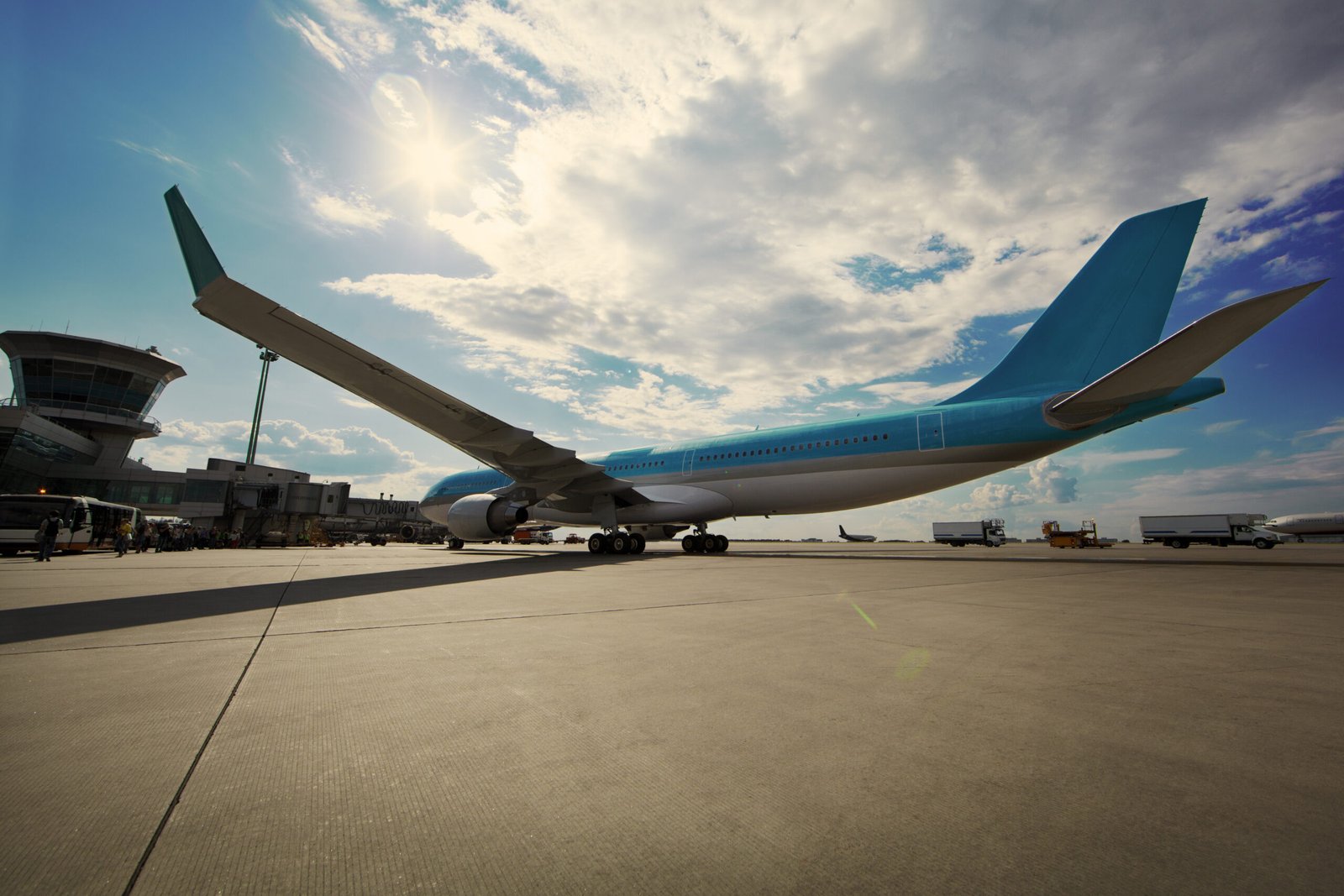Aviation Courses
Clouds and Composites: The Role of Sustainable Aviation Practices in Our Future
As we soar into an era where sustainability is no longer an option but a necessity, the aviation industry is undergoing a transformative shift. From innovative training programs to modern materials, sustainable practices have become integral in shaping the future of flight. One of the fundamental pillars supporting this evolution is education. Aviation schools are stepping up, offering various courses that equip aspiring pilots and engineers with the knowledge needed to embrace eco-friendly aviation.
*Aviation Schools by Types of Courses**
Aviation education encompasses a wide array of disciplines, each targeting specific aspects of flight operations and aircraft maintenance. Here are some key types of courses offered:
1. **Pilot Training Programs**: These courses focus on teaching students how to operate aircraft safely and efficiently. They cover topics such as aerodynamics, navigation, meteorology, and emergency procedures.
2. **Aircraft Maintenance Technician (AMT) Programs**: Students learn about the technical aspects of maintaining aircraft systems, ensuring they meet safety standards. This includes hands-on training with composite materials that contribute to lighter and more fuel-efficient planes.
3. **Aviation Management Degrees**: For those interested in the business side of aviation, these programs delve into operational strategies, regulatory compliance, and sustainable practices within airline management.
4. **Air Traffic Control (ATC) Training**: Aspiring air traffic controllers receive specialized training that prepares them for managing air traffic safely while considering environmental impacts.
5. **Unmanned Aircraft Systems (UAS)**: With the rise of drone technology, schools now offer UAS programs focusing on operation regulations and applications in various fields including delivery services and environmental monitoring.
The diversity in educational pathways not only fosters skilled professionals but also promotes awareness around sustainable practices in aviation.
*Lists of Aviation Blogs, Websites, Social Media Sites**
In addition to formal education, several online resources serve as valuable tools for both current professionals and enthusiasts looking to stay informed about advancements in sustainable aviation practices:
**Blogs**:
– *Airways Magazine*: Covers news from across the industry along with insights on sustainability.
– *Flying Magazine*: Offers articles on pilot experiences intertwined with eco-friendly innovations.
– *The Air Current*: Focuses on deep dives into trends affecting commercial aviation’s future.
**Websites**:
– *FAA.gov*: The Federal Aviation Administration’s official site provides crucial regulations regarding sustainable practices.
– *Aviation Week*: A comprehensive source for industry news that often highlights green initiatives.
**Social Media Platforms**:
– Twitter accounts like @FlyGreen or @SustainableAero provide quick updates on sustainability efforts.
– LinkedIn groups centered around green aviation initiatives foster professional discussions among industry experts.
These platforms facilitate ongoing learning and community engagement essential for advancing sustainable practices within aviation.
*FAA Flight Schools/Airplane Schools/Simulators**
For those eager to embark on their flying journey or enhance their skills sustainably, FAA-approved flight schools present excellent opportunities. Many institutions now incorporate simulators equipped with advanced technologies focused on eco-conscious flying techniques. These simulators enable students to experience real-world scenarios without contributing to carbon emissions during training flights.

By leveraging innovative educational frameworks alongside cutting-edge technology—from composite materials used in aircraft design to virtual simulations—aviation is charting a course toward a greener future. As we navigate through clouds both literal and metaphorical, embracing sustainable practices will ensure that generations can enjoy the freedom of flight while respecting our planet’s limits.
By investing in education today about our skies tomorrow—through diverse courses at aviation schools or engaging with various online resources—we’re not just passengers; we’re active participants steering toward an environmentally responsible aerial landscape!
From Biplanes to Drones: The Evolution of Flight Through the Ages
Aviation has always been a field that captivates the imagination, marking significant milestones in human innovation. From the rudimentary biplanes of the early 20th century to today’s sophisticated drones, the evolution of flight is a remarkable journey filled with technological advancements and educational opportunities. As we continue to explore this fascinating domain, aviation schools have become essential in shaping aspiring aviators and enthusiasts.
When it comes to aviation education, various types of courses cater to different interests and career goals. For those looking to become pilots, traditional flight training programs offer comprehensive curricula that cover everything from basic flying skills to advanced navigation techniques. Many schools also provide specialized courses for commercial pilots, instrument-rated pilots, and even airline transport pilot (ATP) certification.

In addition to pilot training, there are programs focused on aircraft maintenance and repair—these often include hands-on experiences in workshops or hangars where students can work on real aircraft. Similarly, air traffic control programs equip students with vital skills needed for managing air traffic safely and efficiently. With the rise of unmanned aerial vehicles (UAVs), many aviation schools now offer drone piloting courses as well as UAV operations management classes.
To stay connected and informed about aviation trends, numerous blogs and websites serve as valuable resources for both professionals and hobbyists alike. Notable blogs like “The Aviation Herald” provide insights into aviation safety issues through detailed accident reports while “AirlineReporter.com” offers captivating stories about airline travel experiences combined with industry news. Websites such as “Flying Magazine” host extensive articles covering various topics from aircraft reviews to pilot tips.
Social media platforms further enhance community engagement within the world of aviation. On Instagram, accounts like @aviationdaily showcase breathtaking aerial photography alongside informative infographics about aircraft specifications or flying tips. Meanwhile, Twitter boasts active discussions among aviators under hashtags such as #AvGeek or #PilotLife which allow users to share their experiences instantaneously.
For those seeking formal training in America, FAA-approved flight schools are a crucial part of the equation. The Federal Aviation Administration provides a list of accredited institutions that meet stringent standards for quality instruction in both ground school and flight training environments. These schools often feature state-of-the-art simulators that replicate real-life flying conditions without leaving the ground—a perfect tool for honing one’s skills before taking off into the skies.

Flight simulators have revolutionized how pilots train today; they enable immersive practice scenarios ranging from routine flights to emergency situations without risking lives or equipment. Many reputable FAA-certified facilities utilize advanced technology that accurately mimics cockpit layouts along with realistic weather patterns—creating an unparalleled learning environment for prospective aviators.
As we witness continued advancements in aviation technology—from electric planes being designed by visionary companies to autonomous drones performing complex tasks—the educational landscape must adapt accordingly. Whether you’re passionate about becoming a pilot or simply curious about UAV technology, diverse courses are available at various institutions across the country.
In conclusion, exploring the evolution of flight reveals not only technological progress but also highlights how education plays an integral role in shaping future generations within this dynamic field. With countless resources available through blogs, social media sites, FAA-approved flight schools, and specialized training programs dedicated solely to enhancing knowledge around aviation—there has never been a better time to embark on your own aerial journey!
Cloud Computing in Aviation: How Technology is Transforming Air Travel
In an industry that thrives on innovation, cloud computing has emerged as a game-changer for aviation. This technology not only enhances operational efficiency but also redefines how airlines interact with passengers and manage resources. As we soar into the future of air travel, it’s crucial to explore the intertwined realms of education, communication, and training within aviation.
*Aviation Schools by Types of Courses**
For aspiring pilots and aviation professionals, choosing the right educational path is paramount. Aviation schools offer a variety of courses tailored to different aspects of the industry. These can be broadly categorized into:
1. **Pilot Training Programs**: These courses prepare students for their FAA certifications, including Private Pilot License (PPL), Commercial Pilot License (CPL), and Airline Transport Pilot License (ATPL). They cover essential topics such as flight theory, navigation, meteorology, and hands-on flight training.
2. **Aviation Management Courses**: Focusing on the business side of aviation, these programs delve into airport operations, airline management, and logistics. Students learn about regulatory compliance and strategic planning vital for running successful aviation businesses.
3. **Aerospace Engineering**: For those intrigued by aircraft design and maintenance, aerospace engineering programs provide in-depth knowledge about aerodynamics, materials science, and structural analysis.
4. **Air Traffic Control Training**: Specialized courses prepare individuals to manage aircraft flow in busy airspace environments efficiently while ensuring safety.
Each course type offers unique insights into various fields within aviation – paving the way for a well-rounded skill set in this dynamic sector.
*Lists of Aviation Blogs, Websites, Social Media Sites**
Staying updated with trends and developments in aviation requires reliable sources of information. Several blogs and websites are dedicated entirely to this field:
**Airline Reporter**: An excellent resource for news related to airlines’ operations along with reviews.
**The Points Guy**: Focuses on maximizing travel rewards through credit cards while providing insights on airlines’ loyalty programs.
**FlightGlobal**: Offers a comprehensive overview of aviation news covering everything from commercial flights to military developments.
**Simple Flying**: A blog that captures daily happenings in commercial aviation with engaging articles.
Social media platforms are also rich with content from influencers and experts alike:
On Twitter, you can follow accounts like @flightradar24 or @airlinesdotnet for real-time updates.
Instagram features stunning aerial photography from enthusiasts using hashtags like #aviationlovers or #pilotlife.
Engaging with these platforms enriches your understanding while connecting you to a vibrant community passionate about flying.
*FAA Flight Schools/Airplane Schools/Simulators**
When it comes to obtaining necessary flight training credentials under FAA guidelines, numerous reputable flight schools exist across the country. Institutions like Embry-Riddle Aeronautical University or ATP Flight School stand out due to their robust curricula focusing on both practical flying skills and theoretical knowledge.
Additionally, many schools now offer advanced simulators that replicate real-world flying scenarios without leaving the ground. These state-of-the-art devices allow students to practice maneuvers safely before stepping into an actual cockpit—a significant boon considering safety protocols in today’s fast-paced environment.

With cloud computing facilitating data sharing among these institutions—such as enhancing simulator technology—the future looks promising for aspiring aviators. Not only does technology streamline operations; it fosters an interconnected global community eager to learn from each other’s experiences.
In conclusion, cloud computing’s influence permeates every layer of air travel—from education through online resources down to practical training methods—all working together toward creating safer skies for everyone involved. Embrace this transformation; it’s just taking off!
Navigating the Skies: A Beginner’s Guide to Understanding Aviation
Embarking on a journey into the world of aviation can be exhilarating yet overwhelming. With so many paths one can take, it’s crucial to understand the various options available. From specialized schools to an abundance of online resources, this guide aims to illuminate your route through the skies.
### Types of Aviation Schools and Courses
When considering a career in aviation, the first step is selecting the right type of school. Here are some key categories:
1. **Flight Schools**: These institutions focus primarily on training pilots. They offer programs ranging from private pilot certificates to commercial licenses and even advanced ratings for instrument flying.
2. **Airline Transport Pilot (ATP) Schools**: For those aspiring to fly for commercial airlines, ATP schools provide intensive training specifically tailored for airline operations, including multi-engine flying and crew resource management.

3. **Aviation Maintenance Schools**: If you’re more interested in keeping aircraft in top shape rather than piloting them, consider enrolling in an aviation maintenance program. Here, students learn about airframe and powerplant systems, gaining skills necessary for FAA certifications.
4. **Aerospace Engineering Programs**: Universities often feature degree programs focused on aerospace engineering—perfect for those who wish to design and develop aircraft or spacecraft.
5. **Air Traffic Control Training Programs**: These courses prepare individuals for careers as air traffic controllers, teaching them how to manage aircraft safely within controlled airspace.
6. **Simulator Training Facilities**: Many flight schools now utilize advanced simulators that replicate real flying conditions without leaving the ground—ideal for practicing maneuvers or preparing for exams.
### Top Aviation Blogs and Websites
Staying informed about aviation trends is vital for any aspiring aviator or enthusiast. Here are some excellent blogs and websites worth bookmarking:
**AOPA (Aircraft Owners and Pilots Association)**: An invaluable resource packed with articles on flying tips, legal regulations, and industry news.
**Airliners.net**: A vast repository of photographs and forums where aviation enthusiasts share their experiences.
**Flying Magazine**: This publication covers everything from pilot techniques to product reviews.
**Pilot’s Digest**: A blog that offers insights into pilot life while emphasizing safety practices.
**AvWeb**: Focused on news relevant to pilots, AvWeb also features podcasts covering current topics in aviation.
For social media aficionados:
Follow hashtags like #aviationlife or #pilotlife on Instagram for stunning visuals from fellow aviators.
Join Facebook groups such as “Pilots Without Borders” or “Women in Aviation” to network with others who share your passion.
### FAA Flight Schools & Simulators
The Federal Aviation Administration (FAA) maintains a comprehensive list of accredited flight schools across the country—each providing different specialties tailored to student needs. When searching for a suitable school, look out for those that offer both ground instruction and simulator training; these elements combine theoretical knowledge with practical application effectively.

Moreover, utilizing high-quality flight simulators can significantly enhance your learning experience by allowing you to practice critical scenarios without real-world risks involved. Many reputable schools incorporate state-of-the-art technology into their curricula that mimic actual cockpit environments.
In conclusion, understanding aviation is not merely about dreaming of soaring through clouds but involves meticulous planning and education. By exploring various types of schools, engaging with numerous online platforms dedicated to this field, and taking advantage of FAA resources—and perhaps even virtual simulators—you’re well on your way toward conquering the skies! Remember that every seasoned pilot once started just where you are now—so buckle up; adventure awaits!
Flight Safety 101: What Every Traveler Should Know
When it comes to flying, safety is paramount. Understanding the fundamentals of aviation can enhance your travel experience and provide you with peace of mind as you soar through the skies. Whether you’re an aspiring pilot or just a curious traveler, knowing about aviation schools, resources, and regulations will empower you with knowledge that enhances your journey.
*Aviation Schools by Types of Courses**
If you’re captivated by the world of aviation and are considering pursuing a career in this field, numerous educational paths await you. Aviation schools offer diverse courses tailored to different interests:
1. **Pilot Training Programs**: These are foundational for anyone looking to become a commercial or private pilot. Courses typically cover flight theory, navigation, meteorology, and hands-on flight training.
2. **Aircraft Maintenance Engineering**: This program focuses on the technical aspects of aircraft maintenance. Students learn about various systems within an airplane and how to perform inspections and repairs.
3. **Air Traffic Control Training**: This unique course equips students with skills necessary for managing air traffic safely. It covers communication protocols and radar operation.
4. **Aviation Management**: For those interested in the business side of aviation, this course covers airport operations, airline management, and regulatory environments.
5. **Flight Attendant Training**: Focused on customer service and safety procedures, this program prepares individuals for dynamic roles in passenger care during flights.
Each type of course plays a pivotal role in maintaining high standards for safety within aviation.
*Essential Aviation Blogs and Websites**
In addition to formal education, staying informed through reputable blogs and websites is crucial for both travelers and industry enthusiasts alike. Here’s a list that can guide your exploration:
**Airliners.net**: A treasure trove for aviation photography enthusiasts; it also features forums discussing various topics related to flying.
**The Points Guy (TPG)**: While primarily focused on travel rewards programs, TPG offers insights into airlines’ safety records alongside their tips on maximizing travel experiences.
**Flying Magazine**: This publication provides articles covering everything from flight techniques to emerging technologies in aviation.
**Simple Flying**: Stay updated with daily news related to airlines worldwide; they often highlight significant changes in safety regulations too.
Social media platforms can also be rich sources of information:
Follow hashtags like #AvGeek or #AviationSafety on Twitter for real-time updates from professionals.
Join Facebook groups such as “Flying & Avionics” where members share experiences and advice concerning air travel safety.
LinkedIn has numerous professional groups dedicated to discussions around aviation trends, regulations, and best practices.
*FAA Flight Schools/Simulator Training**
The Federal Aviation Administration (FAA) oversees flight training standards across the United States. When selecting a flight school or simulator program, consider these attributes:
1. **Accreditation**: Ensure that any school is FAA-approved; accreditation guarantees adherence to rigorous training protocols ensuring student safety.
2. **Simulator Use**: Modern simulators provide realistic environments without leaving the ground! They are instrumental in teaching emergency procedures safely while enhancing skills before actual flights.
3. **Reputation & Reviews**: Research feedback from former students regarding their training experiences—insights from alumni can reveal invaluable information about a school’s focus on safety measures during instruction.
As travelers embark on their next adventure by air, understanding these facets of aviation not only fosters appreciation but also promotes safer journeys overall. Knowledge is power; equip yourself accordingly! Safe travels!



